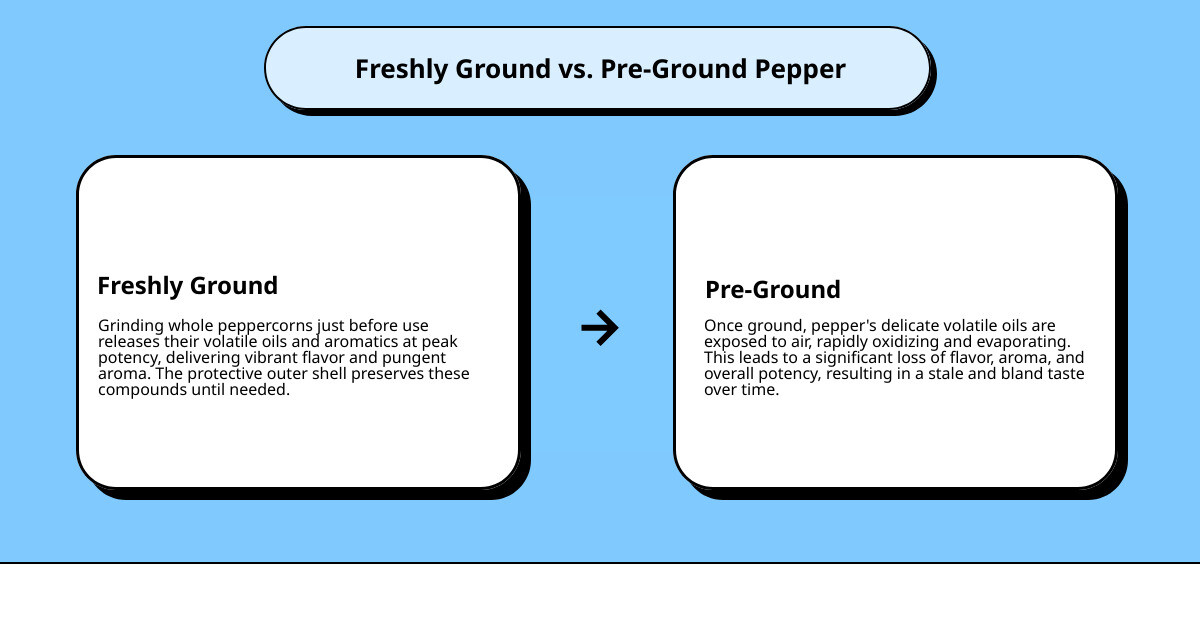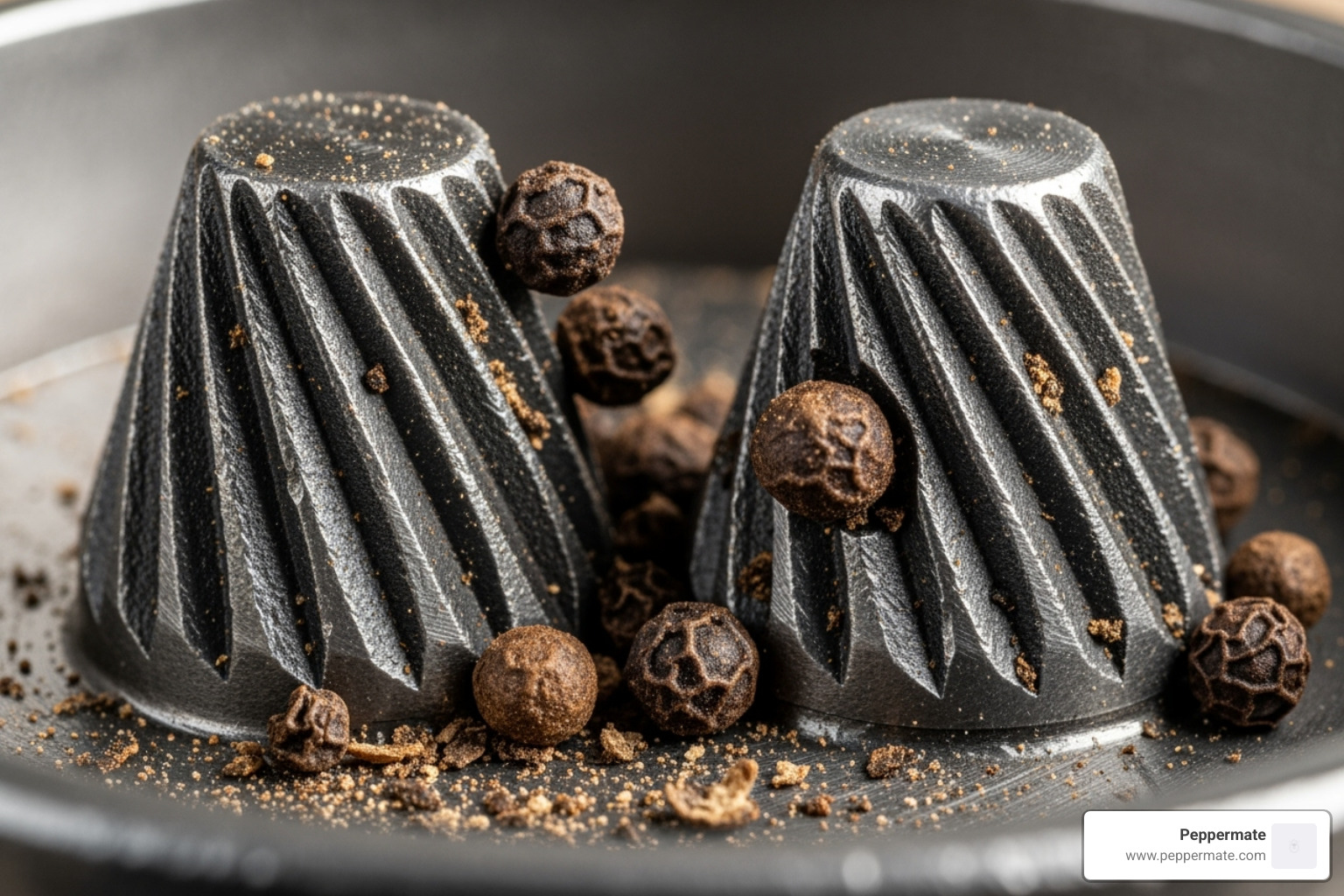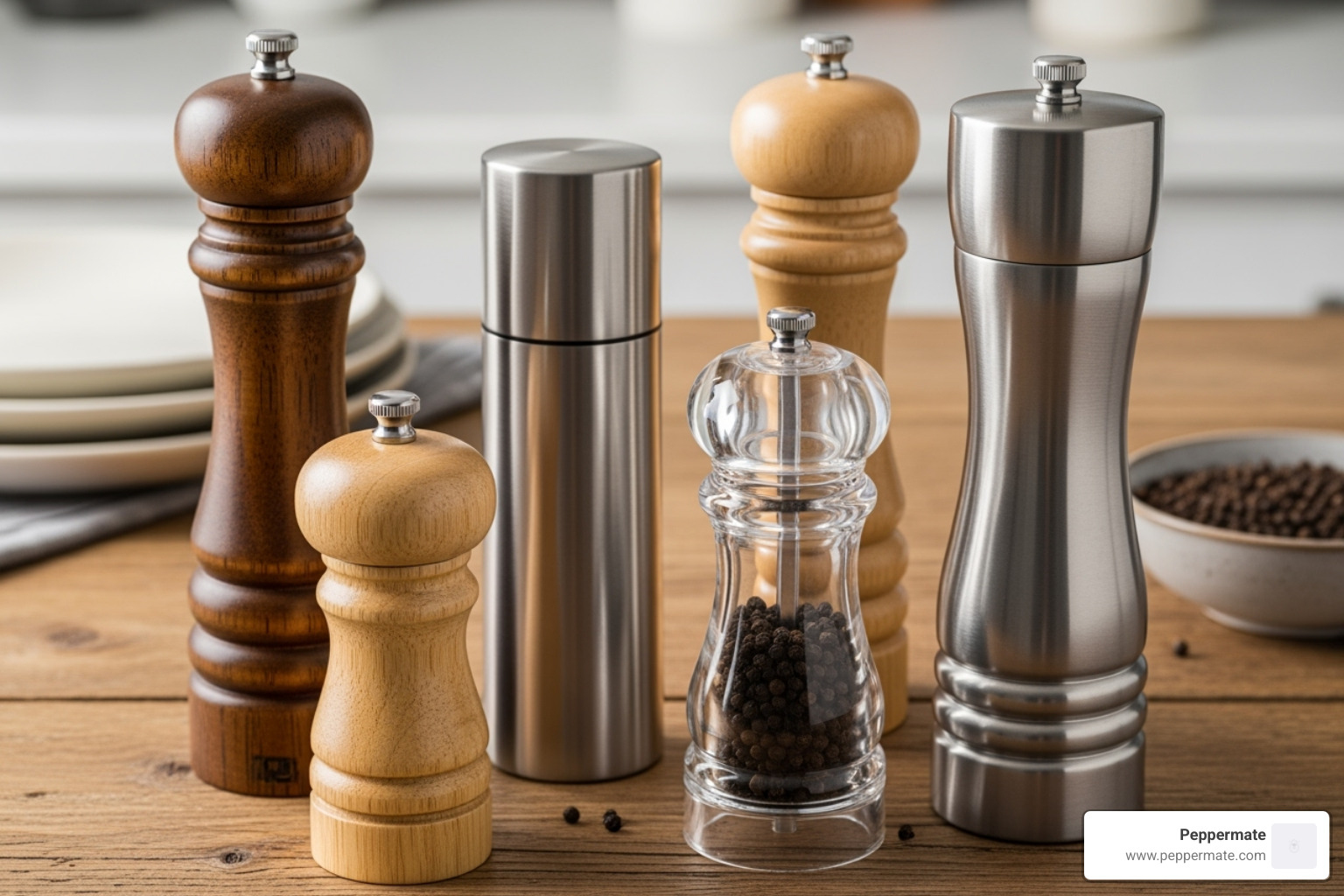The Great Kitchen Terminology Debate
Is a pepper mill the same as a pepper grinder? In everyday kitchen conversation, these terms are used interchangeably - and for good reason. Both describe tools that crush whole peppercorns into freshly ground pepper for your meals.
Quick Answer:
- In common usage: Yes, they're the same thing
- Technically: Subtle differences exist in grinding mechanisms and materials
- For home cooks: The distinction rarely matters - focus on quality and features instead
When it comes to seasoning food with freshly ground pepper, you may find yourself wondering about this terminology puzzle. The truth is, while most people use "pepper mill" and "pepper grinder" to mean the same kitchen tool, manufacturers and culinary professionals sometimes make subtle distinctions based on the internal grinding mechanism and design.
The real story isn't about the name on the box. It's about what's happening inside that device when you twist the top or press the button. Some use traditional burr mechanisms associated with "mills," while others employ different grinding systems that might be called "grinders."
But here's what matters most: freshly ground pepper delivers dramatically better flavor than pre-ground. The volatile oils that give pepper its punch start breaking down the moment peppercorns are crushed. Whether you call your tool a mill or grinder, using it fresh makes all the difference.
Here at Peppermate, we've spent years in the spice industry helping customers understand these distinctions while building premium kitchen tools. Through our experience, we've learned that is a pepper mill the same as a pepper grinder is one of the most common questions home cooks ask when shopping for quality kitchen equipment.

Key is a pepper mill the same as a pepper grinder vocabulary:
- automatic pepper mill grinder
- can you grind salt in a pepper mill
- how to adjust grind on pepper mill
So, Is a Pepper Mill the Same as a Pepper Grinder? A Look Inside
This section digs into the core of the question, revealing that the true distinction lies in the internal mechanics and materials, a detail that has evolved since the first pepper grinders appeared in the 19th century. In fact, the modern pepper grinder was first invented in France all the way back in 1842!
The Heart of the Matter: Grinding Mechanisms Explained
At the core of any device designed to process whole peppercorns is its grinding mechanism. This is where the magic happens, changing hard, whole berries into flakes or powder that open up their intense flavor and aroma.
When we talk about traditional "pepper mills," we're often referring to devices that use what's called a burr grinding mechanism. This system typically involves two abrasive surfaces or "burrs" that work together. As you turn the top or crank, peppercorns are fed between these burrs, which then crush and shear them into a consistent grind. This method is praised for providing precise control over coarseness and for producing a uniform output, which is crucial for even seasoning. The burrs essentially smash the peppercorns between them, creating a consistent result.
Some might argue that a "grinder" could imply a blade-based mechanism, similar to a coffee grinder that uses spinning blades to chop rather than crush. However, for pepper, burr mechanisms are overwhelmingly preferred because they offer superior consistency and preserve the pepper's flavor profile better than a blade that merely chops. Blades can create inconsistent particle sizes and generate heat, which can degrade the volatile oils in pepper. So, while some may use the term "grinder" more broadly, for pepper, the burr mechanism is king for quality results.

Material Matters: Carbon Steel vs. Ceramic Grinders
The material chosen for these internal grinding mechanisms is a critical factor, influencing durability, suitability for different spices, and overall performance. The two primary materials you'll encounter are carbon/steel and ceramic.
Carbon/Steel Mechanisms: Traditionally, many high-quality pepper mills have featured carbon steel or hardened stainless steel mechanisms. These are incredibly strong and durable, designed to withstand the hardness of peppercorns. They are known for their ability to deliver a very fine to coarse grind with precision. However, a significant drawback of carbon steel is its susceptibility to corrosion. If exposed to moisture or, critically, salt, these mechanisms can rust, reducing their efficiency and potentially contaminating your spices. This is why you should never grind salt in a pepper mill with a carbon steel mechanism.
Ceramic Mechanisms: Ceramic grinding mechanisms have gained popularity for several compelling reasons. Firstly, they are exceptionally hard and resistant to wear. In fact, ceramic grinding mechanisms will stay sharp ten times longer than a stainless steel blade! This means a ceramic mill will maintain its grinding efficiency and consistency for a very long time. Secondly, and perhaps most importantly, ceramic is non-corrosive. This makes ceramic mechanisms incredibly versatile, suitable for grinding not just pepper, but also salt (including sea salt, which can be corrosive to metal), and other spices like coriander or cumin. This versatility means you can often find "all-in-one" mills or grinders with ceramic mechanisms that can handle a range of whole spices. While some argue that ceramic might produce a slightly less consistent grind than the very best steel mechanisms, their corrosion resistance and longevity often make them a superior choice for the everyday home cook.
Here’s a quick comparison:
| Feature | Carbon/Steel Mechanism | Ceramic Mechanism |
|---|---|---|
| Durability | Very high, especially for pepper | Moderate to high; stays sharp much longer |
| Corrosion Resistance | Low; rusts with salt/moisture | Very high; impervious to corrosion |
| Suitable for | Pepper only | Pepper, salt, and other hard spices |
| Grinding Precision | Very fine to coarse, excellent consistency | Generally fine to medium, good consistency |
| Typical Use | Premium, dedicated pepper mills | Versatile, multi-spice grinders; excellent for salt |
For more detail on the benefits, you can explore Why Choose a Ceramic Pepper Mill?.
The Verdict on "Is a Pepper Mill the Same as a Pepper Grinder?"
So, after looking under the hood, what's the definitive answer to is a pepper mill the same as a pepper grinder?
For most practical purposes and in common usage, "pepper mill" and "pepper grinder" refer to the same device used to grind whole peppercorns. The purpose is identical: to bring out the fresh flavor and aroma of pepper for your dishes. When you ask a friend for the "pepper grinder" at the table, they won't hand you a power tool for sanding wood; they'll hand you the same device you'd call a "pepper mill."
However, from a manufacturer's or product development perspective, subtle differences can exist, primarily concerning the internal grinding mechanism. A "mill" might traditionally imply a device with a metal burr mechanism, while "grinder" is a more general term that can encompass devices with ceramic mechanisms or even, in rare cases for pepper, blade-like systems.
The distinction often comes down to semantics and marketing. What truly matters is the quality of the internal mechanism, its material, and how well it performs its primary function: delivering freshly ground pepper with adjustable coarseness. The name isn't the full story; the engineering inside is.
Beyond the Burr: How Design and Features Create Distinction
While the grinding mechanism is the heart of any pepper processing tool, the external design elements play an equally important role in defining its character. These features often blur the lines between what we call a "mill" versus a "grinder" even further, creating distinctions that go well beyond the internal mechanics.
Form and Function: Body Materials and Aesthetics
The material wrapping around that precious grinding mechanism isn't just about looks – though aesthetics certainly matter when you're reaching for it dozens of times while cooking. Each material brings its own personality to your kitchen experience.
Wood offers that timeless, warm appeal that never goes out of style. There's something deeply satisfying about the weight and texture of a well-crafted wooden pepper mill in your hands. These pieces often become kitchen heirlooms, developing character over years of use. The downside? Wood needs a bit more care, especially around moisture, and can show wear over time.
Stainless steel brings a sleek, professional kitchen vibe that's practically bulletproof. It's incredibly durable, easy to clean, and won't absorb odors or stains. If you're going for that modern, chef-inspired look, steel delivers every time. Plus, it can handle the daily grind (pun intended) without showing its age.
Acrylic and clear plastic materials solve a problem many home cooks didn't know they had – seeing what's inside. Being able to monitor your peppercorn levels at a glance is surprisingly handy. These materials are lightweight and budget-friendly, though they might develop a cloudy appearance over time with heavy use.
The choice often comes down to how the tool fits into your cooking style and kitchen aesthetic. A substantial wooden mill might command attention as a dining table centerpiece, while a compact steel grinder could blend seamlessly into your countertop workflow.

Manual vs. Electric: Choosing Your Grinding Power
Here's where the is a pepper mill the same as a pepper grinder question gets interesting. The power source often influences how manufacturers market their products, even when the internal mechanisms are nearly identical.
Manual options give you complete control over the grinding process. The classic knob-twist design that most people picture when they think "pepper mill" offers that satisfying tactile feedback – you feel exactly how much pepper you're producing. Then there's the crank-handle style, which provides better leverage and often faster results. Our patented side handle design falls into this category, making grinding effortless even for those with limited hand strength.
Manual mills never need charging, rarely break down, and often last decades. They're also whisper-quiet, which matters more than you might think during early morning or late-night cooking sessions. For those interested in exploring crank-style options, check out Turn and Taste: The Best Crank Pepper Mill Grinders Reviewed.
Electric grinders trade that hands-on control for pure convenience. Press a button, get ground pepper – it's that simple. Many include built-in LED lights, which sounds gimmicky until you're seasoning a dish in dim lighting and realize how helpful it actually is. They're perfect for anyone with arthritis or limited mobility, and they can process larger quantities quickly.
The trade-off? Electric models are typically heavier, more expensive, and dependent on battery life. Nothing's more frustrating than a dead pepper grinder mid-meal prep. If you're curious about hands-free options, explore Hands-Free Flavor: Automatic Pepper Mill Grinders Worth Every Grind.
Does Design Answer if a Pepper Mill is the Same as a Pepper Grinder?
The most crucial design feature that separates good grinding tools from great ones is adjustable coarseness control. This is where the magic happens – being able to dial in the perfect grind for your specific dish.
Picture this: you need a fine grind for a delicate cream sauce where you want pepper flavor without visible specks, then switch to a coarse grind for that perfect steak au poivre where those chunky pepper pieces are part of the visual appeal. The adjustment mechanism makes this possible.
Top knob adjusters are the traditional approach – tighten for fine, loosen for coarse. They work, but finding that sweet spot often involves some trial and error. Bottom dial adjusters are more user-friendly, typically featuring numbered settings or clear indicators that make repeating your preferred grind size effortless.
The best designs offer pre-set settings that click into place, eliminating guesswork entirely. You know exactly what you're getting every time, whether you're seasoning a sauce or preparing a spice rub.
This adjustability feature doesn't definitively answer whether is a pepper mill the same as a pepper grinder, but it does highlight how design elements create practical distinctions that matter more than terminology. A tool with precise grind control performs fundamentally differently than one without it, regardless of what name appears on the packaging.
For detailed guidance on mastering this crucial feature, check out Dialing in Deliciousness: Adjusting Your Pepper Mill Grind.
How to Choose the Perfect Pepper Mill or Grinder for Your Kitchen
Now that we've explored is a pepper mill the same as a pepper grinder from every angle, it's time to put that knowledge to work in your kitchen. Choosing the right tool isn't just about picking something that looks nice on your counter - though that certainly doesn't hurt!
The perfect pepper mill or grinder should feel like an extension of your cooking style. Whether you're a weekend warrior who loves experimenting with new recipes or someone who simply wants better-tasting food without the fuss, the right choice makes all the difference.

Think about your daily cooking routine. Do you find yourself reaching for the same pre-ground pepper shaker day after day? Or are you ready to lift your meals with the intense flavor that only comes from freshly cracked peppercorns? The answers to these questions will guide your decision.
For a comprehensive guide that covers every detail, check out our In-Depth Guide to Choosing the Best Pepper Mills & Grinders.
The grinding mechanism sits at the heart of any quality pepper tool. Remember our earlier discussion about ceramic versus steel? If you want versatility - the ability to grind salt, pepper, and other hard spices without worrying about rust - ceramic is your friend. These mechanisms stay sharp ten times longer than steel blades, making them a smart long-term investment. Steel mechanisms excel at pepper-only precision, but they'll corrode if you accidentally grind salt in them.
Grind adjustability transforms a basic tool into a culinary powerhouse. Look for clear, easy-to-use settings that let you dial in everything from fine powder for delicate sauces to coarse chunks for steak. The best mills have numbered dials or click-settings that take the guesswork out of getting consistent results. For detailed tips on this crucial feature, explore Dialing in Deliciousness: Adjusting Your Pepper Mill Grind.
Ergonomics and ease of use matter more than you might think. A mill that's uncomfortable to operate will end up gathering dust in your drawer. Consider how the tool feels in your hand - does it have a good grip? Is it easy to twist or crank? Our patented side handle design, for example, provides exceptional leverage and comfort, making grinding effortless even when you need a lot of fresh pepper.
Capacity and refilling impact your daily experience. Frequent cooks benefit from larger capacity mills that don't need constant refilling. But capacity means nothing if refilling is a nightmare. Look for wide openings or clever loading mechanisms that prevent spills and frustration. Pro tip: don't fill completely to the brim - leaving some space helps peppercorns flow properly into the grinding mechanism.
Materials and style should match both your kitchen aesthetic and durability needs. High-quality wood offers timeless beauty, stainless steel provides modern sleekness, and clear materials let you monitor your spice levels. Just remember that clear bodies can allow light to degrade peppercorns if left in direct sunlight, so consider your storage habits.
The choice between manual and electric often comes down to personal preference and cooking style. Manual mills offer precise control and never need batteries, while electric models provide effortless operation - especially helpful when you're juggling multiple pans or have limited hand mobility.
By considering these factors together rather than in isolation, you'll find a pepper mill or grinder that not only meets your functional needs but actually makes cooking more enjoyable. After all, the best kitchen tools are the ones you reach for without thinking twice.
Frequently Asked Questions about Pepper Mills and Grinders
Answering the most common questions to help you get the most out of your seasoning tool.
Now that we've explored whether is a pepper mill the same as a pepper grinder, let's dive into the practical questions that come up when you're actually using these kitchen essentials. These are the real-world concerns that pop up in kitchens everywhere!
Can you put salt in a pepper mill?
Here's a question that trips up many home cooks: can you actually use your pepper mill for salt too? The short answer is: it depends entirely on what's inside your mill.
If your pepper mill has a carbon steel or stainless steel mechanism (which many traditional mills do), then absolutely not! Salt is incredibly corrosive to metal. It will cause the grinding mechanism to rust, leading to poor performance and potentially getting metal flakes in your food. Nobody wants rusty bits seasoning their dinner!
But here's where things get interesting. If your mill features a ceramic grinding mechanism, then yes - you can absolutely grind salt in it! Ceramic doesn't corrode, which means it can handle salt, pepper, and pretty much any other hard spice you throw at it. This versatility is one of the biggest advantages of ceramic mechanisms.
At Peppermate, our ceramic mechanisms are specifically designed for this kind of versatility. You can switch between grinding pepper for your morning eggs and coarse sea salt for your evening steak without any worries about corrosion or damage.
Want the full story on this topic? Check out Pepper Mill Problems: Can You Really Grind Salt in There? for all the details.
How do you clean a pepper mill or grinder?
Good news: pepper mills are pretty low-maintenance! Since you're typically only grinding dry peppercorns, they don't get dirty in the traditional sense. But proper maintenance will keep your mill performing like new for years.
The golden rule: never put your pepper mill in the dishwasher or submerge it in water. This is especially important for mills with wooden bodies or metal mechanisms. Water can cause wood to swell and crack, and it can make metal mechanisms rust.
Instead, here's what works: When you're refilling your mill, take a moment to empty out any remaining peppercorn bits and dust. Use a dry brush - even a clean, soft toothbrush works perfectly - to gently clean out the grinding chamber. This prevents buildup that could jam the mechanism.
For the outside, just wipe it down with a slightly damp cloth and dry it immediately. If it's gotten particularly greasy from handling, a tiny bit of dish soap on the cloth works fine - just make sure you dry it thoroughly afterward.
Here's a neat trick: if you have a ceramic mechanism and you've been grinding oily or sticky spices, you can grind a small amount of coarse salt through it. The salt acts like a gentle abrasive, helping to clean the burrs. Just remember to discard that salt afterward! You can find more detailed cleaning tips from experts like those at Epicurious.
The key is avoiding moisture in the grinding chamber. Always make sure everything is completely dry before adding fresh peppercorns.
Why does freshly ground pepper taste so much better?
This might be the most important question of all! Once you understand the science behind fresh pepper, you'll never want to go back to the pre-ground stuff.
It all comes down to volatile oils - these are the tiny aromatic compounds that give pepper its complex flavor and that amazing smell when you first crack open a peppercorn. These oils are incredibly delicate and start breaking down the moment they're exposed to air.
The heat and pungency you love in pepper comes from a compound called piperine. Like those volatile oils, piperine is at its absolute peak potency when it's freshly released from the peppercorn. But here's the kicker: once ground, pepper starts losing these compounds through oxidation - basically, they react with oxygen in the air and gradually disappear.
Think of it like a freshly cut apple that turns brown when exposed to air. That's oxidation in action, and the same thing happens to your pepper's flavor compounds. The difference is, with pepper, you're losing that vibrant taste and aroma that makes food come alive.
Pre-ground pepper has often been sitting around for months, sometimes even years, slowly losing its potency. By the time it reaches your kitchen, it's a shadow of its former self - flat, dull, and lacking that bright pepper punch.
When you grind fresh, you get that immediate burst of aroma and all those complex flavor notes that make pepper such an incredible seasoning. It's honestly one of the easiest ways to instantly upgrade your cooking, whether you're seasoning simple scrambled eggs or finishing a perfectly grilled steak.
The change is so dramatic that once you experience truly fresh pepper, going back to pre-ground feels like seasoning your food with dusty cardboard!
Conclusion: It's Not Just Semantics, It's About Flavor
So, is a pepper mill the same as a pepper grinder? In your everyday kitchen conversations, absolutely. Both terms describe that essential tool sitting on your counter, ready to transform whole peppercorns into the aromatic seasoning that makes your food sing.
But here's what we've found together: the real story goes deeper than just names. Understanding the technical differences in grinding mechanisms - whether you're dealing with ceramic burrs that can handle salt and spices or steel mechanisms built specifically for pepper - helps you open up the best possible flavor for your cooking.
The magic isn't in what you call your tool. It's in what happens when you twist that top or turn that handle. Those volatile oils and piperine compounds that give pepper its kick? They're at their absolute peak the moment those peppercorns crack open. Pre-ground pepper sitting in a shaker has already lost most of that vibrant character.
Whether you're looking for a dedicated pepper-only precision tool or a versatile workhorse that can tackle everything from sea salt to coriander seeds, the right choice comes down to matching the tool to your cooking style. Do you need the corrosion-resistant flexibility of ceramic? The traditional precision of steel? Manual control or electric convenience?
For those seeking that perfect balance of versatility and high-performance, our Peppermate grinders feature durable ceramic mechanisms that handle pepper, salt, and so much more. Our patented side handle makes grinding effortless, while the clear base lets you see exactly what you're working with. And because we believe in the tools we make, every grinder comes with a lifetime warranty.
From our locations in New York and Sydney, we're proud to bring quality kitchen tools to homes around the world. Because at the end of the day, fresh flavor should never be complicated.
Explore our full range of high-quality grinders to find your perfect match.



